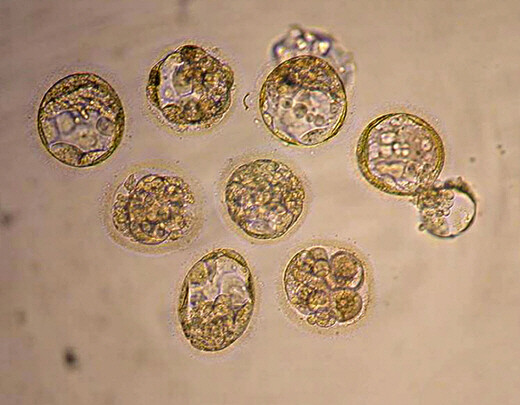hankyoreh
Links to other country sites 다른 나라 사이트 링크
Constitutional Court rules legal status of pre-embryos distinct from human beings

The Constitutional Court of Korea has issued a ruling stating that “pre-embryos,” which have only been fertilized for up to two weeks, cannot be regarded as human beings.
On May 27, nine Constitutional Court justices ruled unanimously that Clauses 1 and 2 of Article 16 of the “Bioethics and Biosafety Law,” which permits the use of fertilized embryos in research on infertility treatment and medical disorders and mandates the disposal of embryos five years after initial fertilization, “do not violate the right to life of human beings” and are therefore constitutional.
A married couple surnamed Nam obtained three artificially inseminated embryos created from their own genetic material at a hospital in Busan in December 2004. One of the three embryos was implanted in Ms. Nam, while the remaining two were destined to be used for further implantations or for biotechnological research if they did not result in pregnancy.
The following year, eleven individuals including the Nams, ethicists, philosophers and doctors, launched a constitutional appeal, saying, “Bioethical laws that define artificially inseminated embryos as non-human bundles of cells treats them as tools for research and mandates their disposal at the end of a preservation period, and is a violation of the fundamental right to life.” The two remaining embryos, which were being stored in a freezer at the time, were included in the group of appellants as “qualified human beings.”
However, the Constitutional Court stated, “Although we acknowledge the basic rights of fetuses before birth, pre-embryos, which have been fertilized but within which the ‘primitive streak’ has not yet formed, cannot be regarded as humans.” The primitive streak appears on embryos that have been fertilized for around 14 days and later forms the spine.
The Constitutional Court stated, “So long as a pre-embryo has not yet been implanted in the mother’s body and its primitive streak has not yet appeared, it is difficult to determine the individual continuity between a human and the embryo.”
This constituted a rejection of the appellants’ assertion that an embryo, a fetus and a newborn baby are one and the same organism on a single path of continuity, and that dividing a human life into distinct stages was arbitrary.
After partially acknowledging that the Nams, as the genetic parents of the embryos, were qualified to make the appeal, the Constitutional Court said, “It is inevitable that large numbers of leftover embryos will be produced because several are created at any one time in order to increase the rate of a successful pregnancy.” In spite of this acknowledgement, however, it ruled that mandatory disposal of embryos after five years was lawful, saying, “An increase in the number of frozen embryos can lead to problems of high cost to society and negligent management.”
Some religious groups expressed regret at the Constitutional Court’s decision.
“Every human being goes through the embryonic stage,” said Father Park Jung-woo, director of the Catholic Archdiocese of Seoul’s Committee for Life. “Catholics regret this decision by the Constitutional Court because we are opposed both to the artificial creation of embryos and to their use, once created, as tools for manufacture, as they are entitled to dignity as living beings.”
Experts in the medical sector, however, expressed the opinion that the Constitutional Court’s decision was not a major diversion from existing bioethical laws and was therefore not highly problematic.
Please direct questions or comments to [englishhani@hani.co.kr]
Editorial・opinion
![[Column] Park Geun-hye déjà vu in Yoon Suk-yeol [Column] Park Geun-hye déjà vu in Yoon Suk-yeol](https://flexible.img.hani.co.kr/flexible/normal/500/300/imgdb/original/2024/0424/651713945113788.jpg) [Column] Park Geun-hye déjà vu in Yoon Suk-yeol
[Column] Park Geun-hye déjà vu in Yoon Suk-yeol![[Editorial] New weight of N. Korea’s nuclear threats makes dialogue all the more urgent [Editorial] New weight of N. Korea’s nuclear threats makes dialogue all the more urgent](https://flexible.img.hani.co.kr/flexible/normal/500/300/imgdb/original/2024/0424/7317139454662664.jpg) [Editorial] New weight of N. Korea’s nuclear threats makes dialogue all the more urgent
[Editorial] New weight of N. Korea’s nuclear threats makes dialogue all the more urgent- [Guest essay] The real reason Korea’s new right wants to dub Rhee a founding father
- [Column] ‘Choson’: Is it time we start referring to N. Korea in its own terms?
- [Editorial] Japan’s rewriting of history with Korea has gone too far
- [Column] The president’s questionable capacity for dialogue
- [Column] Are chaebol firms just pizza pies for families to divvy up as they please?
- [Column] Has Korea, too, crossed the Rubicon on China?
- [Correspondent’s column] In Japan’s alliance with US, echoes of its past alliances with UK
- [Editorial] Does Yoon think the Korean public is wrong?
Most viewed articles
- 1‘We must say no’: Seoul defense chief on Korean, USFK involvement in hypothetical Taiwan crisis
- 2[Reportage] On US campuses, student risk arrest as they call for divestment from Israel
- 3[Column] Park Geun-hye déjà vu in Yoon Suk-yeol
- 4‘Weddingflation’ breaks the bank for Korean couples-to-be
- 5Korea sees more deaths than births for 52nd consecutive month in February
- 6N. Korean delegation’s trip to Iran shows how Pyongyang is leveraging ties with Moscow
- 7Amnesty notes ‘erosion’ of freedom of expression in Korea in annual human rights report
- 8Will NewJeans end up collateral damage in internal feud at K-pop juggernaut Hybe?
- 9N. Korean hackers breached 10 defense contractors in South for months, police say
- 10[Guest essay] The real reason Korea’s new right wants to dub Rhee a founding father